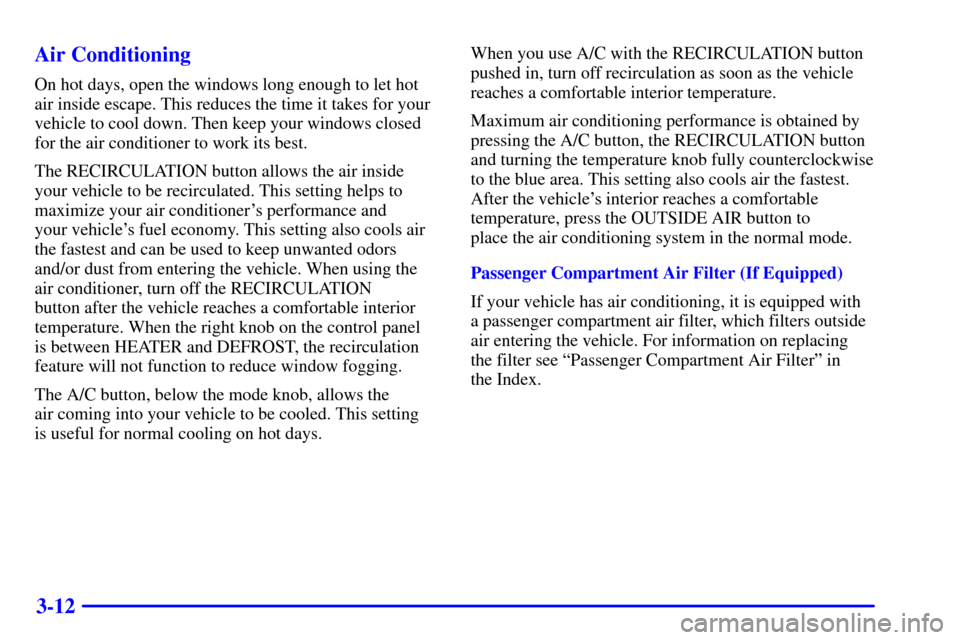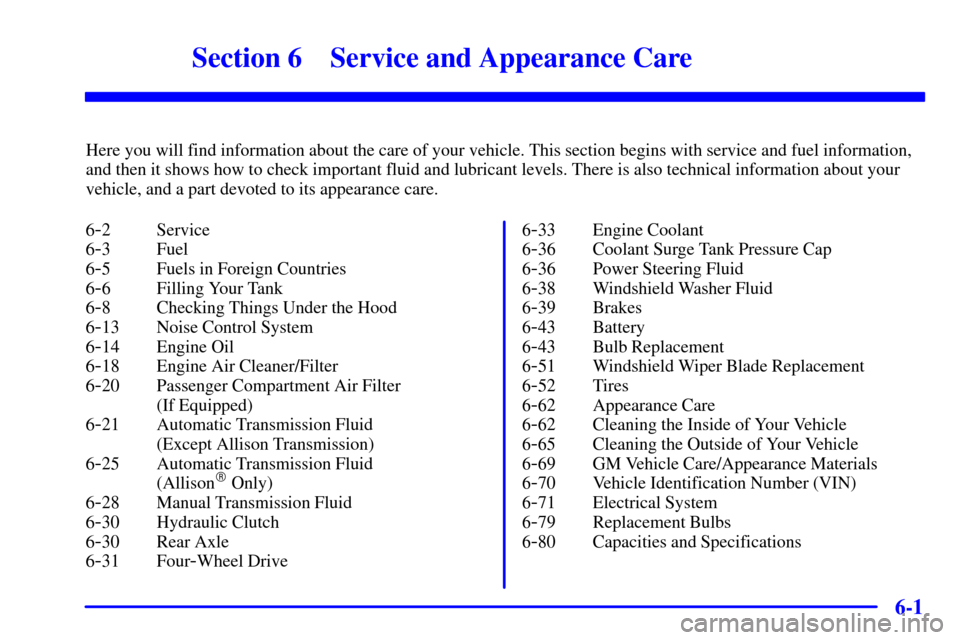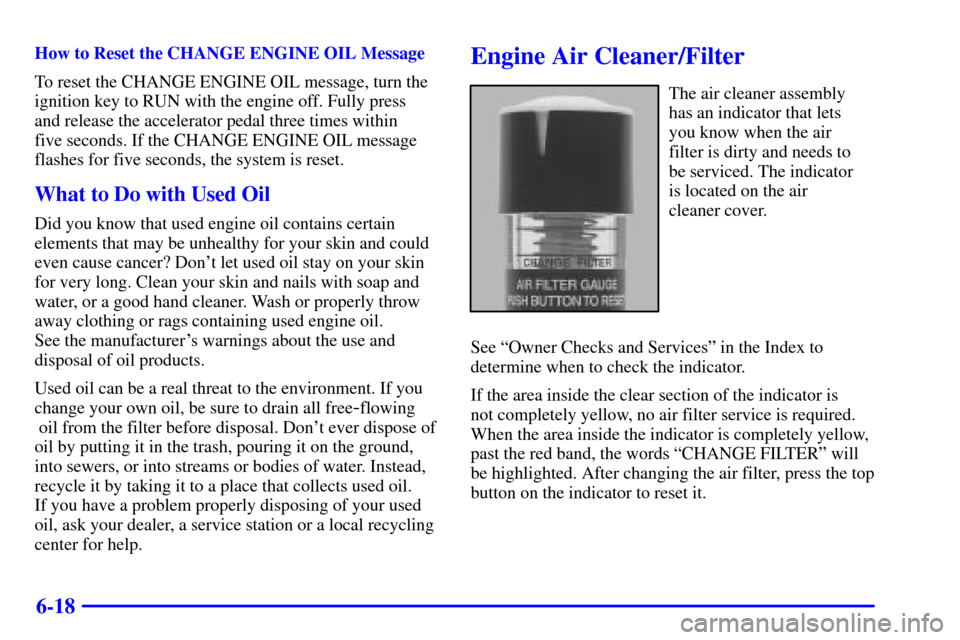Page 6 of 468
iv
Fuel
Checking Fluids and Lubricants
GM Oil Life System™ (If Equipped)
Engine Air Cleaner/Filter
Passenger Compartment Air Filter (If Equipped)
Brakes
Bulb ReplacementWindshield Wiper Blade Replacement
Tires and Wheels
Appearance Care
Electrical System/Fuses and Circuit Breakers
Capacities and Specifications
Normal Maintenance Replacement Parts
Table of Contents (cont'd)
Maintenance Schedule Service and Appearance Care
Section
7
Section
6
Scheduled Maintenance
Owner Checks and Services
Periodic Maintenance InspectionsRecommended Fluids and Lubricants
Maintenance Records
Page 199 of 468

3-12 Air Conditioning
On hot days, open the windows long enough to let hot
air inside escape. This reduces the time it takes for your
vehicle to cool down. Then keep your windows closed
for the air conditioner to work its best.
The RECIRCULATION button allows the air inside
your vehicle to be recirculated. This setting helps to
maximize your air conditioner's performance and
your vehicle's fuel economy. This setting also cools air
the fastest and can be used to keep unwanted odors
and/or dust from entering the vehicle. When using the
air conditioner, turn off the RECIRCULATION
button after the vehicle reaches a comfortable interior
temperature. When the right knob on the control panel
is between HEATER and DEFROST, the recirculation
feature will not function to reduce window fogging.
The A/C button, below the mode knob, allows the
air coming into your vehicle to be cooled. This setting
is useful for normal cooling on hot days. When you use A/C with the RECIRCULATION button
pushed in, turn off recirculation as soon as the vehicle
reaches a comfortable interior temperature.
Maximum air conditioning performance is obtained by
pressing the A/C button, the RECIRCULATION button
and turning the temperature knob fully counterclockwise
to the blue area. This setting also cools air the fastest.
After the vehicle's interior reaches a comfortable
temperature, press the OUTSIDE AIR button to
place the air conditioning system in the normal mode.
Passenger Compartment Air Filter (If Equipped)
If your vehicle has air conditioning, it is equipped with
a passenger compartment air filter, which filters outside
air entering the vehicle. For information on replacing
the filter see ªPassenger Compartment Air Filterº in
the Index.
Page 343 of 468

6-
6-1
Section 6 Service and Appearance Care
Here you will find information about the care of your vehicle. This section begins with service and fuel information,
and then it shows how to check important fluid and lubricant levels. There is also technical information about your
vehicle, and a part devoted to its appearance care.
6
-2 Service
6
-3 Fuel
6
-5 Fuels in Foreign Countries
6
-6 Filling Your Tank
6
-8 Checking Things Under the Hood
6
-13 Noise Control System
6
-14 Engine Oil
6
-18 Engine Air Cleaner/Filter
6
-20 Passenger Compartment Air Filter
(If Equipped)
6
-21 Automatic Transmission Fluid
(Except Allison Transmission)
6
-25 Automatic Transmission Fluid
(Allison� Only)
6
-28 Manual Transmission Fluid
6
-30 Hydraulic Clutch
6
-30 Rear Axle
6
-31 Four-Wheel Drive6
-33 Engine Coolant
6
-36 Coolant Surge Tank Pressure Cap
6
-36 Power Steering Fluid
6
-38 Windshield Washer Fluid
6
-39 Brakes
6
-43 Battery
6
-43 Bulb Replacement
6
-51 Windshield Wiper Blade Replacement
6
-52 Tires
6
-62 Appearance Care
6
-62 Cleaning the Inside of Your Vehicle
6
-65 Cleaning the Outside of Your Vehicle
6
-69 GM Vehicle Care/Appearance Materials
6
-70 Vehicle Identification Number (VIN)
6
-71 Electrical System
6
-79 Replacement Bulbs
6
-80 Capacities and Specifications
Page 352 of 468
6-10 Engine Compartment Overview
When you lift up the hood on the VORTEC 4300 V6 engine, you'll see the following:
A. Engine Air Cleaner/Filter
B. Coolant Surge Tank
C. Air Filter Restriction Indicator
D. Engine Oil Dipstick
E. Automatic Transmission Dipstick
(If Equipped)F. F a n
G. Engine Oil Fill
H. Power Steering Fluid Reservoir
I. Remote Negative (
-)
Terminal (GND)
J. Remote Positive (+) TerminalK. Brake Fluid Reservoir
L. Clutch Fluid Reservoir
(If Equipped)
M. Underhood Electrical Center
N. Battery
O. Windshield Washer Fluid Reservoir
Page 353 of 468
6-11
When you lift up the hood on the VORTEC 5300 V8 engine (VORTEC 4800 and 6000 V8 engines similar), you will
see the following:
A. Engine Air Cleaner/Filter
B. Coolant Surge Tank
C. Air Filter Restriction Indicator
D. Engine Oil Dipstick
E. Automatic Transmission Dipstick
(If Equipped)F. Engine Oil Fill
G. Fan
H. Remote Negative (
-)
Terminal (GND)
I. Power Steering Fluid Reservoir
J. Remote Positive (+) TerminalK. Brake Fluid Reservoir
L. Clutch Fluid Reservoir
(If Equipped)
M. Underhood Electrical Center
N. Battery
O. Windshield Washer Fluid Reservoir
Page 354 of 468
6-12
When you lift up the hood on the VORTEC 8100 V8 engine you will see the following:
A. Engine Air Cleaner/Filter
B. Coolant Surge Tank
C. Air Filter Restriction Indicator
D. Engine Oil Dipstick
E. Automatic Transmission Dipstick
(If Equipped)F. Engine Oil Fill
G. Fan
H. Remote Negative (
-)
Terminal (GND)
I. Remote Positive (+) Terminal
J. Power Steering Fluid ReservoirK. Brake Fluid Reservoir
L. Clutch Fluid Reservoir
(If Equipped)
M. Underhood Electrical Center
N. Battery
O. Windshield Washer Fluid Reservoir
Page 360 of 468

6-18
How to Reset the CHANGE ENGINE OIL Message
To reset the CHANGE ENGINE OIL message, turn the
ignition key to RUN with the engine off. Fully press
and release the accelerator pedal three times within
five seconds. If the CHANGE ENGINE OIL message
flashes for five seconds, the system is reset.
What to Do with Used Oil
Did you know that used engine oil contains certain
elements that may be unhealthy for your skin and could
even cause cancer? Don't let used oil stay on your skin
for very long. Clean your skin and nails with soap and
water, or a good hand cleaner. Wash or properly throw
away clothing or rags containing used engine oil.
See the manufacturer's warnings about the use and
disposal of oil products.
Used oil can be a real threat to the environment. If you
change your own oil, be sure to drain all free
-flowing
oil from the filter before disposal. Don't ever dispose of
oil by putting it in the trash, pouring it on the ground,
into sewers, or into streams or bodies of water. Instead,
recycle it by taking it to a place that collects used oil.
If you have a problem properly disposing of your used
oil, ask your dealer, a service station or a local recycling
center for help.
Engine Air Cleaner/Filter
The air cleaner assembly
has an indicator that lets
you know when the air
filter is dirty and needs to
be serviced. The indicator
is located on the air
cleaner cover.
See ªOwner Checks and Servicesº in the Index to
determine when to check the indicator.
If the area inside the clear section of the indicator is
not completely yellow, no air filter service is required.
When the area inside the indicator is completely yellow,
past the red band, the words ªCHANGE FILTERº will
be highlighted. After changing the air filter, press the top
button on the indicator to reset it.
Page 361 of 468
6-19
Your air cleaner is located in the passenger's side front
corner of the engine compartment. See ªEngine
Compartment Overviewº in the Index for more
information on location.1. To remove the air filter, loosen the screws on the
cover. Lift the cover upward. Lift the filter from the
air cleaner housing. Care should be taken to dislodge
as little dirt as possible.
2. Clean the filter sealing surface and the filter housing.
3. Install the new filter.
4. Install the cover and tighten the screws on the air
cleaner cover.
Refer to the Maintenance Schedule to determine when to
replace the air filter. See ªOwner Checks and Servicesº
in the Index.